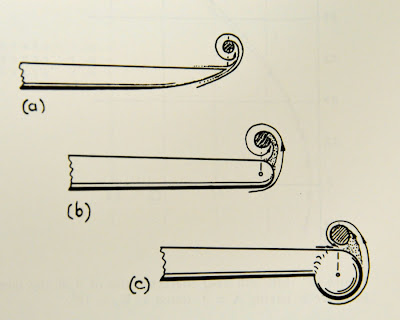My previous post cited the work of Dr. Hoerner in the development of wingtips which produce smaller vortices, which consequently produces less drag, which consequently allows more speed (for a given thrust), and consequently a better rate of climb....
Clearly the Hoerner wingtips are a desirable thing. While there are other ways to produce effective vortice reduction (for instance, vertical winglets or even flat plates), the Hoerner wingtip is more easily fabricated, and frankly, in my opinion, just looks darn sexy.
Soooo, it's worthwhile to spend a couple of minutes reviewing Dr. Hoerner's research, so we can guess what positive results these wingtips will give us.
Below is a basic illustration of a wingtip vortice, which I have copied from Dr. Hoerner's most excellent book, "Fluid Dynamic Drag".
 |
| Vortice at wingtip, from Fluid Dynamic Drag, by Hoerner |
Dr. Hoerner reviewed several different kinds of wingtip configurations, including square wings with sharp edges (which is exactly what our Belite ultralight airplane has), along with round rectangular edges, sharp rounded wings, sharp full wings, and more. He also reviewed vortices and drag reduction around wingtip fuel tanks (which are not in our current Belite innovation plans.) With each kind of wingtip shape, he calculated and presented the effective span of the wing -- in other words, a longer wing is a better thing -- and if you get that length 'for free' (by using better wingtips), that is a really good thing.
The very worst wingtip is a rounded wingtip, with a round cross section. The very best wingtips are ones which have a sharp cross section.
And interestingly, the square wingtip with a square edge is nearly as good as the very best wingtip, but not quite. It is worthwhile to quote Dr. Hoerner on this topic:
"Theory predicts minimum induced drag for elliptical lift distribution across the span.... however, directly in one case... that a rectangular wing (with sharp lateral edges) does not have a higher drag due to lift than the elliptical wing."
Wow. Score one for Belite, and the game of innovative improvement hasn't even started!
Back to Dr. Hoerner's writing:
"It is seen that the most effective plan forms are the rectangular, the moderately tapered ones and those which have a long trailing edge.... In other words, to make the span of the rolled-up vortex system, or the effective span of a wing of given basic shape, as wide as possible, it is favorable to keep the tip vortices apart from each other as far downstream as possible."
Now if I look back at his charts, I do see that sharp wingtips have an advantage over the square wingtip with square edges, and all of those have huge advantages over rounded wingtips.
So the Hoerner wingtip is taking it to the next level.
Let's find some more interesting remarks from my new best friend, Dr. Hoerner. He makes some comments about the most ideal wingtip shape, which I (and others) now call "Hoerner wingtips":
"In case of [Hoerner wingtips], which is the most favorable one concerning small drag due to lift as well as to minimum sectional drag, it appears that one additional effect is the bent-up shape. Experimental data.... on a small-aspect-ratio wing, confirm that this feature is important. Combination of [Hoerner wingtips] with a moderately tapered plan form is believed to be the most effective..."
So things get a bit 'guess-work-eee' from here. But we think that we know the following:
* sharp wingtips reduce the size of the vortice -- which is what the Hoerner wingtip is all about
* the addition of the Hoerner wingtip spreads the trailing edge, adding span, and further separating the vortice
* sharp wingtips have less drag at higher angles of attack, which is where ultralights spend more time at than higher speed airplanes
Hey, wait a minute. I better provide some documentation for a couple of those points. Here's another illustration from the book which helps:
 |
| Improvement shown with Hoerner wingtips -- with square wingtips not far behind! |
Here's a final helpful illustration, showing the cross section of vortices with sharp vs round wingtips:
 | ||||||
| Decreased vortice size with Hoerner wingtips (a) vs round (b) or wingtip tanks (c) |
Finally, some conclusions...
Q. So what is all of this worth to a Belite ultralight aircraft?
A. We believe the aerodynamic effective span will increase by a little over 2 feet. However, we are cheating a bit, because the Hoerner wingtips will add about 20 inches of real span all by themselves. The increase in effective wing area is 7+ square feet! (with an original wing area of about 108 square feet).
Q. What performance increases will result?
A. Hopefully I'll see an improvement in climb rate, a reduction in stall speed, a reduction in takeoff roll, a reduction in landing roll (I'd like to beat my personal measured 100.5' landing record -- which I know I'll be able to do [because I've already done it in another Belite, before I even started talking about Hoerner wingtips :-) ]) and more...
Q. What weight penalty do the wingtips entail?
A. Substantially less than a 8 ounces per wing, vs. our existing square design. Really!
Q. What if they don't work quite that well?
A. Then I'll get to figure out why, and I'll have the coolest looking ultralight airplane on the planet.
My thanks to Dr. Hoerner, and his wonderful book. I believe my quotes and illustrations taken from his book fall under fair use doctrine.
I am also indebted to Mike, who is building this wonderful test airplane with Hoerner wingtips for me.
If you want an overview of what else I'm working on (and willing to talk about) you can read it here:
Upcoming 2012 Product Innovations at Belite Aircraft
-- James Wiebe, 2011 EAA August Raspet award recipient













